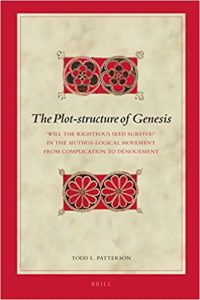 Todd L Patterson, Ph. D. (2012), Trinity International University, is Assistant Professor of Old Testament at Matej Bel University, Banská Bystrica, Slovakia.
Todd L Patterson, Ph. D. (2012), Trinity International University, is Assistant Professor of Old Testament at Matej Bel University, Banská Bystrica, Slovakia.
Overview
There are two main questions that Patterson takes up as he writes his book: 1) What is the structure of the book of Genesis? 2) What is the point of the book of Genesis? For Patterson, the answer to the first question is that, instead of following a chronological flow of thought, it follows a “muthos-logical” pattern. He defines “muthos-logical” as “one because of another” (6). He fleshes out this to mean “complication to dénouement” (7). The answer to the second question is that the righteous seed must survive (10).
Evaluation
This is a unique book since the primary concern of the book is not homiletical, exegetical, or even theological. The primary concern is structural. Patterson is concerned with the structure of the book and what that structure drives us to conclude about the meaning of Genesis. It’s a fascinating look at Genesis in that we are forced to not only confront that the content is there, but why it is there, arranged as it is.
As one might expect, he does a commendable job of letting us know that the ten toledoths introduce what follow. Like any good commentator, he gives us options for how the book is arranged at a macro level. He then proposes his own structure. The more he delves into the micro level of the book, the more his conclusions become tenuous. For example, he writes, “The narrative of Jacob’s struggling with God is only the concrete confirmation of Jacob’s character, and the mark left on his body becomes the indelible characteristic for all of Israel” (170). One could reach the same conclusion for many of the main people in the book of Genesis. But, even with these small weaknesses, Patterson does give us some aid in stitching together the larger units of Genesis into a more cohesive whole.
The other main point of the book is worth a read. He asks repeatedly throughout the book, “Will the righteous seed survive?” In a very thorough way, Patterson asks that, if the survival of God’s people is tied to the line of Adam and travels through the line of the patriarchs, then will they be righteous enough to receive the blessing handed down to them? The path through the book of Genesis becomes a path where God “filters out” the family trees that fall outside the line of the promise (17). But after the threats from outside the line of the promise are dealt with (by the flood), is the line of the promise righteous enough to survive on its own? The reader has to wade through 200+ pages to arrive at the answer. And the answer is, “no.” But Patterson does a beautiful job of showing just how powerless the seed of Adam and Abraham was to survive on its own.
Conclusion
Although Brill binds some beautiful books, complete with headbands and thick, almost glossy pages that my fountain pen likes, nevertheless, the $130+ price tag that Brill attaches to the book might be out of our reach. If, however, thinking through the structure of the book of Genesis and pondering how it is that such unrighteous people are recorded in the line of the righteous seed, then this book might be for you. Do note that some of the largest theological questions are not addressed, and the ones he does address are only given a brief treatment so that he can get back to writing about his thesis. With this in mind, if you do read this, you will get some useful gems out of it.

